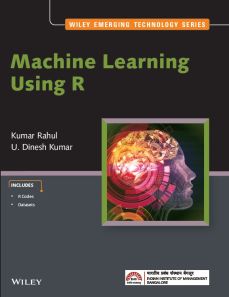Machine Learning Using R
ISBN: 9789354246111
452 pages
For more information write to us at: acadmktg@wiley.com

Description
Machine Learning Using R aims to make ML concepts and model development using R simpler for students and practitioners. This book covers the theoretical concepts behind ML algorithms and illustrates use of R for developing ML models using datasets from customer relationship management, healthcare, finance, human resource management, social media, and sports. The book discusses challenges and remedies in building machine learning models using several real-life cases which the authors have worked upon as a part of consulting engagements.
Chapter 1 Machine Learning and R
1.1 Introduction to Analytics and Machine Learning
1.2 Why Machine Learning Algorithms?
1.3 Framework for Development of Machine Learning Algorithms
1.4 Introduction to R
1.5 Popularity Index for R
1.6 R Installations – Getting Started
1.7 RStudio
1.8 Understanding RStudio IDE
1.9 Anaconda
1.10 Anaconda Navigator
Chapter 2 Data Preprocessing
2.1 Data Preprocessing and Descriptive Analytics Using data.frame in R
2.2 IPL Dataset Description
2.3 Loading Dataset to R
2.4 Operations on data.table
2.5 Group by Operations
2.6 Keys and Binary Search-Based Subset
2.7 Join operations
2.8 Data Table, Data Frame, and Package DT
Chapter 3 Data Visualization
3.1 Data Visualization in R
3.2 IPL Dataset Description
3.3 Install Packages
3.4 Invoke packages
3.5 Exploration of Data Using Visualization
Chapter 4 Probability and Distributions
4.1 Overview
4.2 Probability Theory – Terminology
4.3 Random Variable
4.4 Binomial Distribution
4.5 Poisson Distribution
4.6 Exponential Distribution
4.7 Normal Distribution
4.8 Central Limit Theorem
4.9 Hypothesis Testing
4.10 Analysis of Variance (ANOVA)
Chapter 5 Supervised Learning Algorithm: Linear Regression
5.1 Simple Linear Regression
5.2 Steps for Regression Model Building
5.3 Building Simple Linear Regression Model
5.4 Example: Predicting MBA Salary from Marks in Grade 10
5.5 Model Diagnostics
5.6 Making Predictions and Measuring Accuracy
5.7 Multiple Linear Regression
5.8 Predicting the SOLD PRICE (Auction Price) of Players in Indian Premier League
5.9 Developing Multiple Linear Regression Model
5.10 Model Diagnostic
5.11 Making Predictions and Measuring Accuracy
Chapter 6 Classification Problems
6.1 Classification Overview
6.2 Binary Logistic Regression
6.3 Predicting Which Employee Will Leave the Organization Using Logistic Regression
6.4 Model Diagnostic
6.5 Gain Chart and Lift Chart
6.6 Decision Tree Learning 216
6.7 Model Selection
Chapter 7 Advanced Machine Learning
7.1 Overview
7.2 How Do Machines Learn?
7.3 Gradient Descent
7.4 Bias-Variance Trade-off
7.5 Strategy to Improve ML Models – Bias Variance Trade-off
7.6 Machine Learning – Regression Using glmnet Package
7.7 Machine Learning – Regression Using Caret
7.8 Results summary
7.9 Machine Learning – Logistic Regression Using glmnet
Chapter 8 Ensemble Methods
8.1 Overview
8.2 Random Forest
8.3 Class Imbalance Problem
8.4 Random Forest Using h2o Package
8.5 Gradient Boosted Machine – Regression
8.6 Gradient Boosting Machine – Classification
8.7 Gradient Boosting Machine using h2o Package
8.8 XGBoost using h2o Package
Chapter 9 Text Analytics
9.1 Overview
9.2 Data Scrapping
9.3 Regular Expression
9.4 Packages for Text Analytics
9.5 Data Import
9.6 Text Prepreprocessing
9.7 Twitter Data Visualization
9.8 Sentiment Analysis
9.9 Sentiment Analysis with Negative Words
9.10 Document Term Matrix
9.11 Topic Modelling
Summary
Exercises
Bibliography
Further Readings
Index




